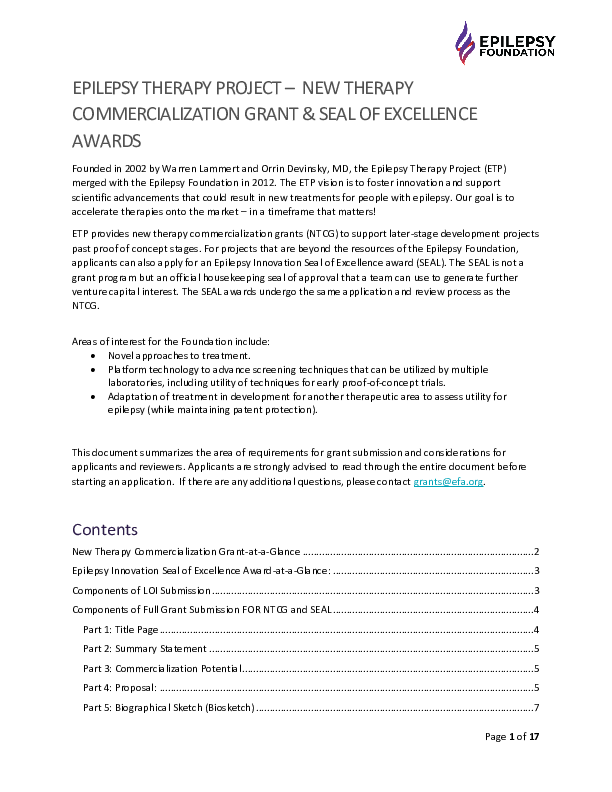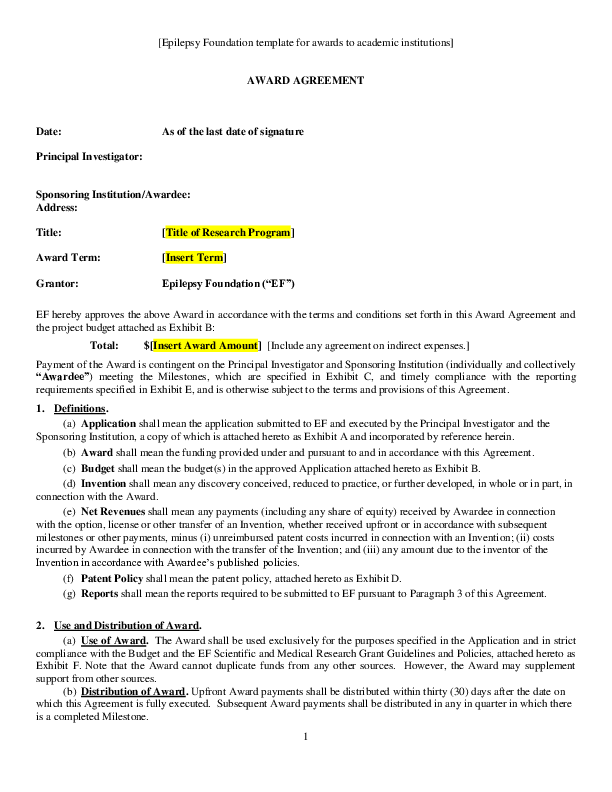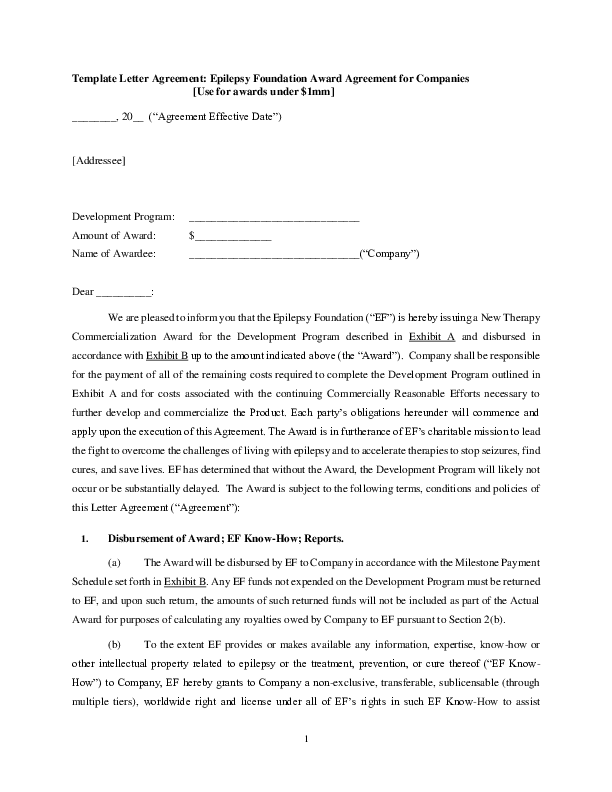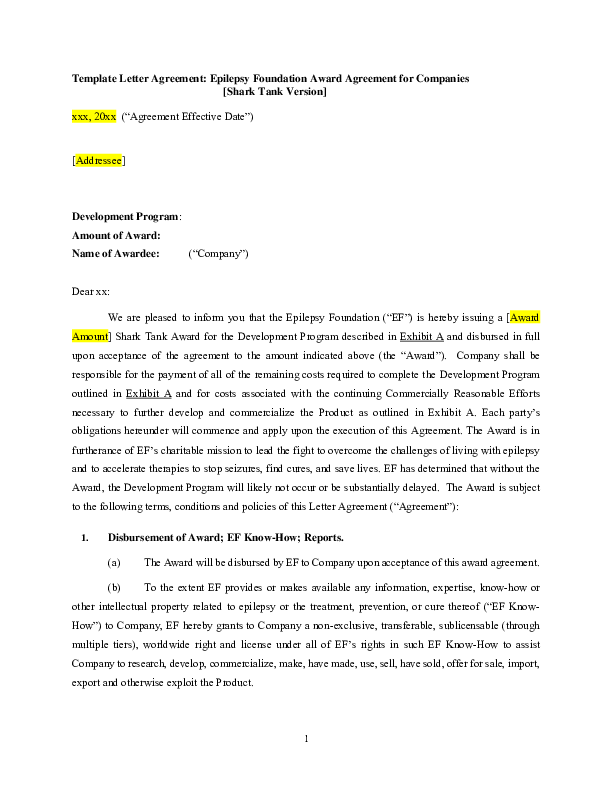New Therapy Commercialization Grants
Driving the Development of New Therapies for Epilepsy; Accelerating the Advancement of Research from Laboratory to Persons Living with Seizures
The purpose of the New Therapy - Commercialization Grants Program and Epilepsy Innovation Seal of Excellence Award is to drive the development of new therapies for epilepsy, accelerating the advancement of research from the laboratory to the patient.
The Program seeks to advance the development of new therapies including but not limited to medicines, biologics or devices. All proposals must demonstrate a clear path from the lab to the patient and are evaluated with consideration for their potential value to patients, likelihood of successful development including regulatory approval and the timeframe of development. The Program also encourages 1:1 matching grants to academic and commercial entities to support the commercialization of novel approaches to the treatment of epilepsy. Preference will be given to proposals that already have a commercial partner engaged to assist with development, and to proposals that have committed or matched funding from a sponsoring institution, commercial partner or other third party source.
The program includes:
- New Therapy Commercialization Grants for new, innovative research from leading scientists and startup companies. Grants are up to $200,000 over a one to two-year period.
- Epilepsy Innovation Seal Of Excellence Award certifies that a specific company meets the Epilepsy Foundation’s standards of excellence and would address a major unmet need for our community. This award may be used by the awardee to generate interest in the project from external funding sources.
Applications undergo a competitive, in-depth review by both a Scientific and a Business Advisory Board. Please review our process and check out our Upcoming Grants for how to apply!
Areas of interest include:
- Novel approaches to treatment.
- Platform technology to advance screening techniques that can be utilized by multiple laboratories, including utility of techniques for early proof-of-concept trials.
- Adaptation of treatment in development for another therapeutic area to assess utility for epilepsy (while maintaining patent protection).
Proposals should be beyond the proof of concept stage to be competitive
For example:
- Diagnostics and/or device applications should be at later stage feasibility testing or in the proof of value stage (i.e. there should be a minimal viable product [MVP] prototype with a product IFU [instructions for use])
- Small molecule and/or biologic applications must have at least one lead compound identified in the proposal. Note that this compound may be in pre-IND (Investigational New Drug phase of FDA). Investigators of drugs are strongly advised to have their compounds screened, as appropriate, by the NINDS Epilepsy Therapy Screening Program (ETSP) prior to submitting an application.
- Clinical programs applications must have a reasonable protocol and sample size to assure that the results will be meaningful; studies of patients should describe the type of seizure/epilepsy that will be investigated.
Priorities will be given to:
- Research programs that might not otherwise be funded through traditional sources.
- Projects that encourage collaboration among scientists and industry. Every day, millions of people lose seconds, minutes or hours of their lives to seizures. These precious moments can never be regained. That's why the Epilepsy Foundation - New Therapy Commercialization Grants Program funds research with the potential to discover new treatment options, and ultimately cures, and supports the commercialization of research originating either in the private or the academic sector in order to facilitate the development of new treatments.
- Projects with full intellectual property (IP) rights (composition of matter) are preferred over method of use IP.
Click here to see what we have funded previously.
Frequently Asked Questions
Q: How do I apply and what is the review process?
A: See the document below for an overview of application and review process. Note that these grants undergo both a business and scientific advisory review.
Q: When are the grant cycles open to apply?
A: There are two funding cycles per year (letters of intent are usually due in late January and Early August). Please take a look at our Upcoming Grants Cycle to see the specific dates. In order to guarantee review, applications MUST BE RECEIVED by the deadline date. NO additional information for an application will be accepted after the due date including supplemental data. Extensions to the application submission deadline will not be granted, with the rare exception made for severe extenuating circumstances.
Q: What is the maximum amount the Epilepsy Foundation provides for a New Therapy Commercialization Grant?
A: Awardees can apply for up to $200,000 for a maximum of 2 years.
Q: When would I submit for an Epilepsy Innovation Seal of Excellence?
A: For solutions that require investments in the millions, the Epilepsy Foundation provides an Epilepsy Innovation Seal of Excellence. These awards do not come with an award amount. However, this is a vehicle for a project to receive official approval from the Foundation. The official seal award can be used to secure additional venture capital from outside sources. Applicants for the Seal Award should include information on the total amount needed to complete the project. Review the guidelines below to learn how to apply.
Q: Can this application come from a public private partnership?
A: Yes. We encourage 1:1 matching grants to academic and commercial entities to support the commercialization of novel approaches to the treatment of epilepsy. Preference will be given to proposals that already have a commercial partner engaged to assist with development, and to proposals that have committed or matched funding from a sponsoring institution, commercial partner or other third party source. If another entity, such as a pharmaceutical company, is providing partial funding support or in-kind contribution to the study (such as study drug and/or placebo), please provide a letter of support detailing the agreed-upon funding or resources provided in the application.
Q: Do you accept international applications?
A: Yes. We welcome a broad span of applications from anywhere in the world.
Q: What does a grant agreement look like?
A: We have two template agreements depending on whether the applicant is from an academic institution or working at a company.
Click the link above to see a template of a grant agreement with an academic institution.
Choose the link above for a template grant agreement for a company.
Q: What does a Shark Tank funding agreement look like?
A: Please see the document below for a template grant agreement for a company applicant. If there are additional questions regarding the funding arrangement, we are always happy to discuss any concerns or issues that you might have. Our primary goal is to be supportive of the awardee and assist in getting a successful product to market!
Q: If there are additional questions regarding the Epilepsy Therapy Program, whom should I contact?
A: Please contact our Senior Director of Innovation, Dr. Sonya Dumanis (sdumanis@efa.org)
Resources
Epilepsy Centers
Epilepsy centers provide you with a team of specialists to help you diagnose your epilepsy and explore treatment options.
Epilepsy Medication
Find in-depth information on anti-seizure medications so you know what to ask your doctor.
Epilepsy and Seizures 24/7 Helpline
Call our Epilepsy and Seizures 24/7 Helpline and talk with an epilepsy information specialist or submit a question online.
Tools & Resources
Get information, tips, and more to help you manage your epilepsy.






